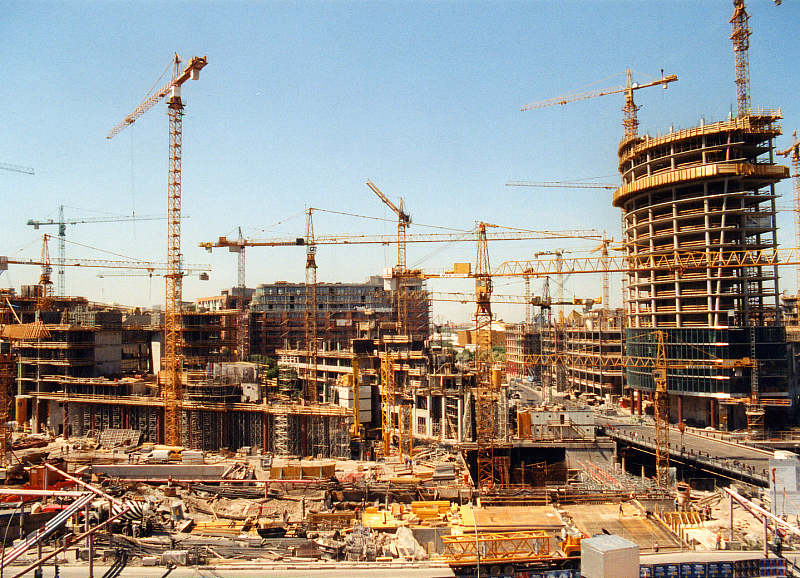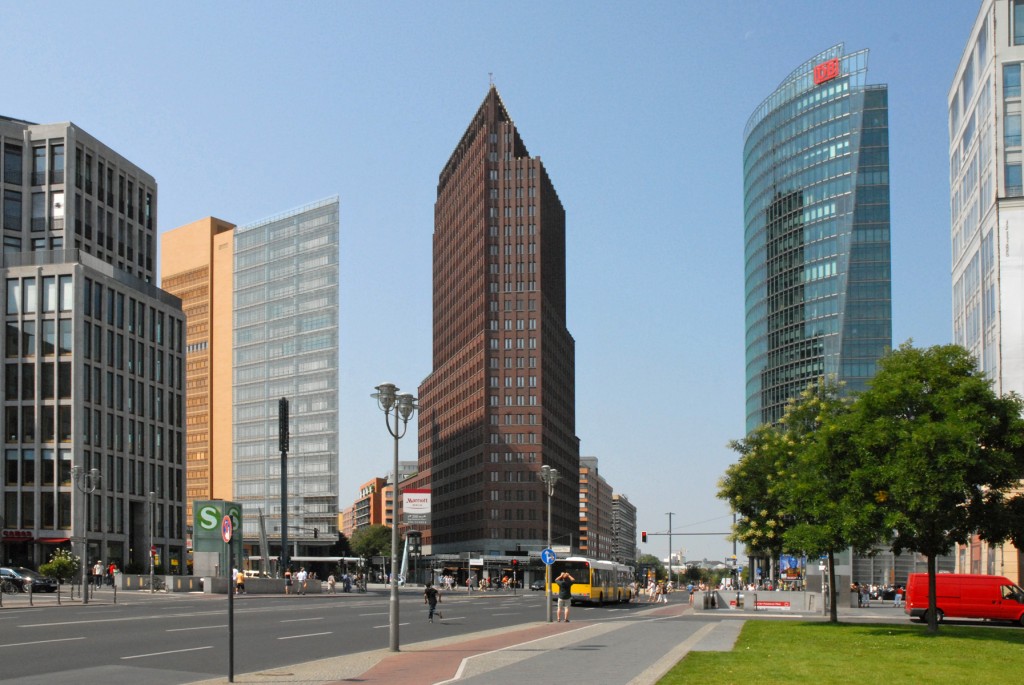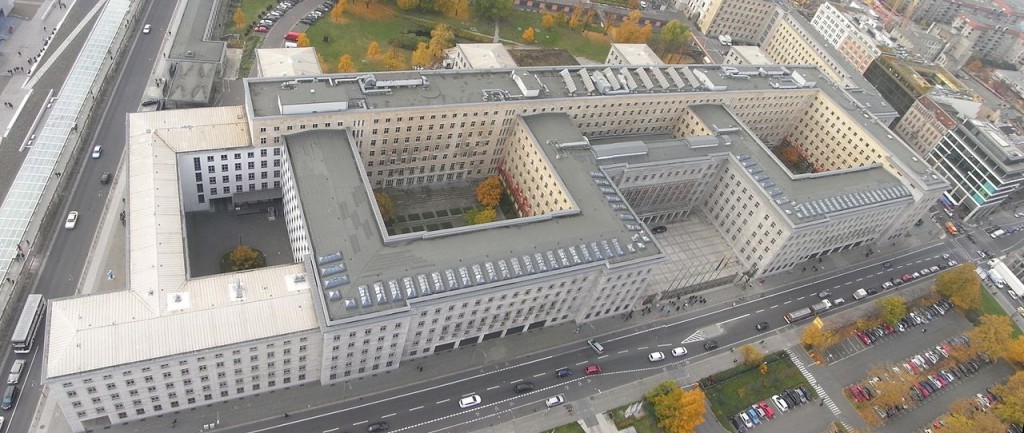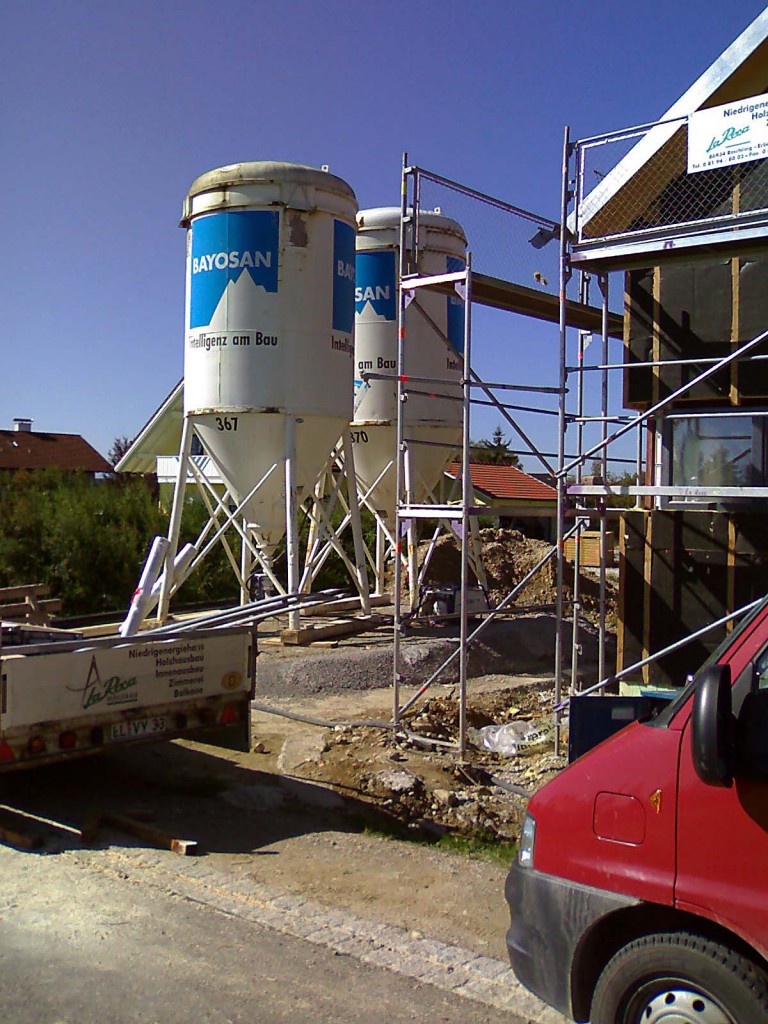| Follow us on Google+ |
Follow us on YouTube |
Follow us on Facebook |
Follow us on Linkedin |
 Potsdamer Platz Berlin (in the 1990’s)
Potsdamer Platz Berlin (in the 1990’s)
Plastering – O L D |
V |
N E W |
|
Plastering Introduction
I’ve been plastering in Northern Ireland and various places places
for over 30 years now. In that time there has clearly been a lot of progress
in Plastering and Construction generally. It is my intention to attempt to
review and perhaps try to quantify that progress home and away.
Hawk and trowel Plastering
Hawk and trowel Plastering for example is still a major part of local
building and gypsum finish plaster is still widely used locally, unlike
Western Europe generally.
This post will try to examine local building techniques before reviewing them
in context with some major Germany projects from the 1990’s in the hope of
perhaps comparing that progress in two main construction sectors.
- Larger Civil and Commercial Projects
- Domestic Housing developments.
Authors experience
It will draw directly on the Authors experience’s both in Northern
Ireland and sub contracting on Potsdamer Platz “The new Centre of Berlin
were the main section of the Berlin Wall once stood and also the largest
Building Site in Europe during the nineties”. It will also use any
other sourced material deemed relevant.
Potsdamer Platz
Larger Projects – Machine plastering and the Hawk & Trowel
On Large Civil and Commercial Projects the advantages of modern
building techniques seem self evident. Machine plastering is ideal for
large expanses of solid exterior and interior walls and uses
relatively small teams of Men, normally 2 or 3 men per Machine
with only one skilled plasterer required per team.
The video below shows 4 men Plastering 5’000 Sq Ft in 6 hours.
In Traditional Plastering those figures can be almost reversed with
normally 2 or 3 Plasterers required per Labourer, giving Machine
Plastering an obvious advantage regarding Man Power .
The superior quality and speed of machine plastering and higher output
per man on larger projects soon becomes apparent with some very large
walls becoming problematic to do with Hawk and Trowel and are
usually broken up beaded out in sections using extra men.
I should also add that in all the projects I sub contracted in Germany
“Finish” Plaster as it is called in the UK was never used.
The largest Project I sub contracted on
in Germany was Detlev-Rohwedder-Haus now the new Federal Tax
office just off Potsdamer Platz (Formerly the old Luftwaffe HQ) were its entire
135,000 Square Meters of solid walls were renovated and machine
plastered in Sand Cement which was “Napped up”smooth using a
sponge float. This was our only detail on the entire project albeit a
massive one.
Ceilings
All Ceilings were all either MF or Dry lined (Drywall) and all the walls were
napped up and finished painters using what is called filler. It is
normally bright white, applied with wide blades, is air drying and takes
most of the day to go off.
Renovation
As this was essentially a renovation, job Sand Cement was deemed less
expensive and more suitable for its structural elements but Larger New
Projects also use one coat machine plaster which is sprayed edged up,
closed in and finished relatively quickly.
Machine Manufacturers boast that in Plastering approx 80% of the work is
transporting, mixing and getting the material on the Wall.
As Sean Haseley demonstrates below it certainly looks rather stress free.
Material Management
In all our time on the New German Tax Office I never seen a bag of Cement
once. All Cement on site was stored in 16 or 20 Ton Silo’s.
Each Silo had a compressor unit at its base called the Hopper, each Hopper
pumped the powder down a two inch pipe perhaps a hundred meters or more
to its designated Plastering Machine which could then mix the required
amount before spraying it on the required wall. Once the spray was finished
the Plastering Machine would be cleaned thoroughly including passing a
sponge ball through its hoses and rinsing.
The Silo’s were filled by Lorries identical to those carrying Oil with the powder
also pumped in by compressed air. No Fork lifts or extra men required
only a single driver pulling a single lever to pump the entire 20 Ton
load.
Contract
This Plastering Contract was 135,000 square meters in Total to the main
contractor so the logistical implications of using Traditional Plastering
Methods on this scale are immense which seemingly confirms
that certainly on Larger Projects ;
Machine Plastering is more effective than Traditional Hawk & Trowel
Plastering.
Part Two. Joint Filler versus Finish
The advantages of Dry lining (Drywall) on large construction projects
also seems self evident with ceilings and Partition Walls often measured in
hundreds of square meters and in some cases Ceilings measured in thousands
of square meters with walls often 6 meters or more high in extended open
planned areas. Like Machine Plastering “Jointing with Joint filler”
(Drywall) large areas of Ceiling or Walls is logistically more manageable
with smaller teams or often even lone “Jointer’s” working long hours
seamlessly finishing very large areas of Drywall to optimum quality without
the stress of large Teams of Plasterers Frantically mixing and “Skimming” and
in a lot of cases “Polishing” the Finish which is bad for decoration.“Finished”
ceilings are also more susceptible to cracking and depend too much on the Skill
of the available work force for Quality.
Traditional methods of “Skimmed” Ceilings and Wooden Studded Partition
Walls also Perform well below modern techniques on Fireproofing,
Acoustics, Quality of Materials and Finish
I think it is safe to say that on larger projects The Modern Techniques of
Machine Plastering and dry wall put the Hawk and Trowel in the shade.
Residential Housing Developments
In Residential housing developments area’s are generally smaller
than Larger Civil and Commercial Projects with most walls
below 10m2. The stairwell is generally the largest wall in any Semi
with even luxury bungalows still well within the capabilities of any
Hand Plasterer.
The smaller number of meters and rooms in each house would
seem at first glance to give the hand plasterer a mobility and
perhaps a feasibility advantage with the heavy machine to
manoeuvre with hoses etc. attached although generally machines
are positioned in the ground floor hallway were they can normally
reach most of the house. This however can create its own
feasibility problems, especially for other trades.
With each house only worth 300 + square meters of
sand cement/one coat Machine Plaster, one might ask is it
really worth the bother of using a machine and moving it and
setting it up every time. Firstly in terms of Sand and cement most
Machine Teams would float a house in a day if not slightly over, and
take less than two days to plaster your average semi in one coat
machine plaster which can create other feasibility problems.
Towards the end of the nineties in Germany when the German
Economy began to slow down I began to take on smaller Machine
Plastering contracts outside Berlin.
Around this time I regularly had fax’s from a Company
near Stuttgart saying they had many houses and 4 years
work me, which at first seemed impressive and they
eventually received two plasterers to this particular job,
Geordie Mick and Cockney John.
The project was a domestic housing development with
mostly semi detached houses and in these house’s there were special details
which slowed the work rate down. one detail I remember particularly was a
special metal frame formed around pipework etc, which was filled with a new
mixture of sand & Cement and polystyrene balls which cut back created an
instant pipe casing ready for tiling. In spite of these details and some
problems with the machines supplied by the Company. In Spite of this Mick
and John were able to do a minimum of two houses per week. When the
company rang me panicking they had 6 houses sitting waiting to be plastered
sadly however after approximately a month Mick and John had run out of
work and were victims of their own success.
In the UK and Republic of Ireland, it would be difficult to find a
residential development were house’s were completed at the rate of
two house’s a week which could keep two good Plasterers in steady work.
Based upon this one it might be argued that Machine Plastering is not ideally
suited to domestic house building in the United Kingdom thereby giving the
traditional hawk and trowel plasterer (at least on interior residential
plastering) a logistical advantage over the machine, however I would imagine
there are better ways round the issue with direct labour with say one plasterer
beading and preping and plastering and another labourer operating the
machine part time as needed with other regular duties on the site.
In Domestic Housing developments. Dry lined Metal Stud
Partitions and Dry lined Suspended ceilings are much easier to
manage and monitor during the build than traditional wooden studs with the
setting of the stud tracks often (including the foreman) – which effectively
meaning the project is set out.
Dry lining can also be stopped or started seamlessly – holes and traps
can be left open and blended perfectly after wards unlike finish. If the metal
partitions are done correctly using 45KG Rock wool, Acoustic band
and Acoustic Hangers for the ceilings their vastly superior performance
complete will leave the traditional techniques a long way behind.
Internal angles are finished with Acrylic mastic(painters mate) which allows for
movement. Finish on the other hand is trowelled right into internal corners
making it more prone to cracking. Finish is also weaker, less resilient but yet
harder and more prone to cracking than jointing compound. Finish can also crack
if dried out quickly and can’t “blend” like Dry Wall and most plasterers will admit
that a Patch is always a patch unless you skim the whole wall.
In Summary
When it comes to interior construction dry wall just
becomes too appealing for reasons not obviously to do with frailties of
traditional techniques.
-
Drywall partitions are lighter and faster than brick or block etc.
- Drywall ceilings require less structural support
-
Drywall is a smother yet more open decoration friendly finish.
-
Drywall has superior acoustics in terms of Sound insulation.
-
Dry wall provides typically F30 to F90 but can provide up to F240.
-
Drywall can be modified & refurbished easier.
Furthermore in Time Context. It appears that apart from Central London and
selected sites around the Country the UK is lagging significantly behind what
Germany was using almost twenty years ago in terms of Construction
techniques Generally and Plastering in Particular.





